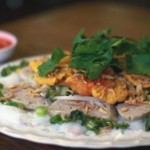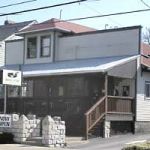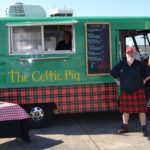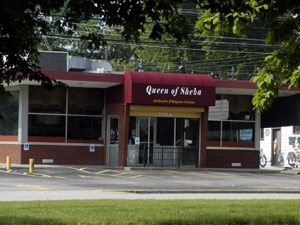 |
|
| Ethiopian restaurant Queen of Sheba recently moved into the old Mazzoni’s building across from Bowman Field. Photo by Robin Garr. |
LEO’s Eats with LouisvilleHotBytes.com
“Don’t eat with your fingers!” This nugget of parental advice is known to just about every child. It’s an integral part of the process of growing up with good manners.
From time to time, though, there’s a certain pleasure in casting aside knives and forks and diving right in. This casual approach works with fried chicken, for instance. Or the appropriately named finger sandwiches. Or a rack of juicy ribs. Just bring plenty of napkins.
Aficionados of ethnic food know another finger-food delight that, with a bit of experience, can actually be consumed with a degree of delicacy in a white-tablecloth setting. We’re talking about Ethiopian fare, an East African alternative that may currently be enjoyed at two local eateries.
Both Blue Nile and Queen of Sheba serve Ethiopian food in the traditional style, all dishes spread out on a large, communal plate lined with thin, spongy injera bread, with more of the bread served in rolls that replace our Western knives and forks.
The Blue Nile menu explains: “Ethiopia is a country with a strong community. This community spirit is reflected in the manner in which Ethiopians traditionally eat: Meals are served on platters to be shared among diners. Instead of actual utensils, Ethiopians use injera as a substitution for a fork or a spoon. Eating like an Ethiopian requires you to tear off a piece of injera, cover the morsel you desire and scoop it into your mouth in one graceful swoop. In keeping with Ethiopian tradition, Blue Nile serves its food on a platter with injera as opposed to providing individual plates for each guest. Plates and utensils are available on request.” (The same is true at Queen of Sheba, where places are neatly set with burgundy cloth napkins but nary a utensil in sight. However, a knife and fork will quickly be provided if you ask.)
We’ve pitched into Ethiopian meals at both establishments recently and come away happy and well fed.
Queen of Sheba’s on the move
This peripatetic Ethiopian restaurant has now come to rest in the former home of Mazzoni’s near Bowman Field, its third local location. First it was Abyssinia, located in the dark old building on Frankfort Avenue that housed the original Bobby J’s; then it became Queen of Sheba, replacing India Palace in an old motel on a gritty strip of Bardstown Road just outside the Watterson Expressway.
The old Mazzoni’s building has been thoroughly renovated. With the big wooden bar gone, the room looks more airy and bright, colorful with desert earth tones and Ethiopian art, large plate-glass windows affording a good view of Bowman Field and plenty of sunlight on long summer evenings. A dozen tables are draped in white cloth – some embroidered with Ethiopian patterns – under protective plastic. Bud vases sprout bright artificial red and white roses.
Every table was occupied on a recent week night … it appears that the Queen has brought over its clientele from Bardstown Road and added more. This is good news for management, but both the kitchen and service were struggling a bit under the strain. Dishes were slow to come out, and service was friendly but spotty. Queen of Sheba has a short beverage menu, a few wines and beers, but at the time of our visit, they were still waiting for their license – “maybe in a month,” the server said.
To accommodate the eat-with-injera tradition, many Ethiopian dishes resemble stews or porridges, the easier to pick up with a piece of thin bread between the fingertips. Bewildered by the variety of tips (sautéed dishes) and wots (stewed dishes), we settled on one of the many combo dishes, a “tips and vegetable combination” featuring a choice of doro (chicken) or sega (beef) tips, cabbage atakilt, green bean fossolia and beef alicha sega wot ($14 for one, $25 for two).
A very large, sky-blue plate was spread with a round of injera with one of the dishes in each quadrant, a work of art in contrasting colors: atakilt, which is long-cooked, thin-sliced, sweet cabbage; sega wot, long-cooked beef and potatoes in a thick, pale-green sauce; doro tips, chicken bites sautéed with green peppers and strips of onion; and fossolia, bright and crisp and tangy green beans, carrots, onions and tomatoes. The plate also included a couple pools of spicy red lentils and small salad piles of lettuce and red onion, plus six extra rolls of injera on the communal plate. Dishes are colorful and aromatic, although nothing on our plate was nearly as fiery as Ethiopian fare is reputed to be.
Traditional injera is a thin, pale-tan flatbread made from an Ethiopian grain called teff. Served at room temperature, it’s spongy in texture, smooth on one side and bubbly on the other. It doesn’t take long to master the technique of tearing off a bite-size square and using it to pick up your food, although the uninitiated will make good use of their napkins. (Don’t forget, there’s no shame in calling for a fork.)
The combo plate for two, with a couple of tall glasses of ice water in lieu of the unavailable beer, came to a very reasonable $26.50 plus a $5.50 tip.
Queen of Sheba
2804 Taylorsville Road
459-6301
Robin Garr’s rating: 84 points
Blue Nile offers Ethiopian fare downtown
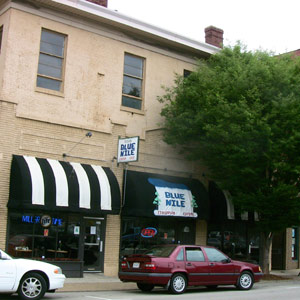 |
|
| Blue Nile Ethiopian Restaurant recently opened downtown at Fifth and Chestnut. Photo by Robin Garr. |
Another modification of a much-used space, Blue Nile Ethiopian hasn’t altered the look of its downtown facilities much from its previous occupants, Manoosh’s and Saffron’s Buffet. Two long dining rooms are painted white over gray, decorated with a few Ethiopian paintings. A third room contains a short bar and a couple of spillover tables. A pair of short buffet tables offer an all-you-can-eat lunch arrangement (originally Wednesday and Friday, although the server told us this may be extended). On a hot summer day, the restaurant is not overly air-conditioned; a couple of large floor fans stirred the warm air a bit.
We’ve gone a couple of times for the buffet, which generally offers a half-dozen wots and tips (here spelled “tibs” in an alternate reading of the Amharic alphabet of Ethiopia), salads and injera.
Some of the buffet dishes are identified with labels stuck to the top of the “sneeze shield.” I generally just pick a little of everything without trying too hard to keep track. There are almost always a couple of vegetarian dishes and at least one or two chicken or beef stews. One bright-red ground beef dish is fiery with Ethiopian red-pepper berbere sauce and jalapeños, but most of the dishes range in the one- to two-alarm scale. There’s plenty of flavor here, but some of the dishes are a bit greasy; try spooning your portion from the side of the pan if this concerns you.
Although the buffet selection isn’t large, it’s possible to try everything and get a filling meal for a fair price: Two lunch buffets at $8.99 each plus an iced tea for one racked up an affordable $20.38 tab plus a $4 tip.
Blue Nile Ethiopian Restaurant
558 S. Fifth St.
625-7400
Robin Garr’s rating: 77 points
